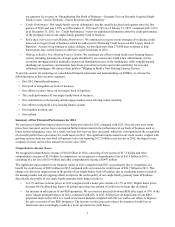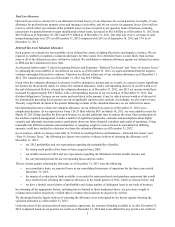Fannie Mae 2012 Annual Report Download - page 17
Download and view the complete annual report
Please find page 17 of the 2012 Fannie Mae annual report below. You can navigate through the pages in the report by either clicking on the pages listed below, or by using the keyword search tool below to find specific information within the annual report.12
in 2012 and the implementation of changes to HARP. Our activities enabled our lender customers to finance approximately
3,898,000 single-family conventional loans and loans for approximately 559,000 units in multifamily properties during 2012.
One of FHFA’s strategic goals for our conservatorship involves gradually contracting our dominant presence in the
marketplace. Despite this goal, our market share remains large and even increased in 2012 as we have continued to meet the
needs of the single-family mortgage market in the absence of substantial private capital. We currently estimate that our
single-family market share was 43% in 2012, compared with 37% in 2011. These amounts represent our single-family
mortgage acquisitions for each year, excluding delinquent loans we purchased from our MBS trusts, as a percentage of the
single-family first-lien mortgages we currently estimate were originated in the United States that year. Because our estimate
of mortgage originations in prior periods is subject to change as additional data become available, these market share
estimates may change in the future, perhaps materially.
We remained the largest single issuer of mortgage-related securities in the secondary market during the fourth quarter of
2012, with an estimated market share of new single-family mortgage-related securities issuances of 48%, compared with 52%
in the third quarter of 2012 and 54% in the fourth quarter of 2011. For all of 2012, we estimate our market share of new
single-family mortgage-related securities issuances was 49%, compared with 48% for 2011.
We remained a constant source of liquidity in the multifamily market in 2012. We owned or guaranteed approximately 22%
of the outstanding debt on multifamily properties as of December 31, 2012.
Helping to Build a New Housing Finance System
In addition to serving as the leading source of residential mortgage credit in the secondary market, we are committed to doing
our part to improve the mortgage finance system. We have devoted significant resources towards helping to build a new
housing finance system for the future, primarily through pursuing the strategic goals identified by our conservator. In
February 2012, the Acting Director of FHFA sent a letter to Congress in which he provided FHFA’s strategic plan for Fannie
Mae and Freddie Mac’s conservatorships. The plan identified three strategic goals for the conservatorships:
• Build. Build a new infrastructure for the secondary mortgage market;
• Contract. Gradually contract Fannie Mae and Freddie Mac’s dominant presence in the marketplace while simplifying
and shrinking their operations; and
• Maintain. Maintain foreclosure prevention activities and credit availability for new and refinanced mortgages.
In March 2012, FHFA directed us to implement a set of corporate performance objectives and related targets for 2012,
referred to as the 2012 conservatorship scorecard, which provides the implementation roadmap for FHFA’s strategic plan for
Fannie Mae and Freddie Mac. As described in “Executive Compensation—Compensation Discussion and Analysis—
Determination of 2012 Compensation—Assessment of Corporate Performance on 2012 Conservatorship Scorecard,” we met
substantially all of the 2012 conservatorship scorecard objectives.
Liquidity
During 2012, we issued a variety of non-callable and callable debt securities in a wide range of maturities to achieve cost-
efficient funding and to extend our debt maturity profile. We believe that our ready access to debt funding since the beginning
of 2009 has been primarily due to the actions taken by the federal government to support us and the financial markets.
Accordingly, we believe that continued federal government support of our business and the financial markets, as well as our
status as a GSE, are essential to maintaining our access to debt funding. Changes or perceived changes in federal government
support of our business and the financial markets or our status as a GSE could materially and adversely affect our liquidity,
financial condition and results of operations, or our ability to continue as a going concern. Demand for our debt securities
could decline in the future, as the Administration, Congress and our regulators debate our future. See “MD&A—Liquidity
and Capital Management—Liquidity Management” for more information on our debt funding activities and “Risk Factors”
for a discussion of the risks to our business posed by our reliance on the issuance of debt securities to fund our operations.
Outlook
Financial Results and Dividend Payments to Treasury. Our financial results improved significantly in 2012, and we expect
our annual net income to remain strong over the next few years. As a result of home price increases and improvement in the
performance of our book of business, our total loss reserves decreased in 2012, which corresponded to the recognition of a
benefit (rather than a provision) for credit losses. Because loans remain in our book of business for a number of years, the
credit quality of and guaranty fee we charge on the loans we acquire in a particular year affects our results for a period of
years after we acquire them. Accordingly we expect improvements in the credit quality of our loan acquisitions since 2009
and increases in our charged guaranty fees on recently acquired loans to benefit our results for years to come, especially
because these loans have relatively low interest rates, making them less likely to be refinanced.
























